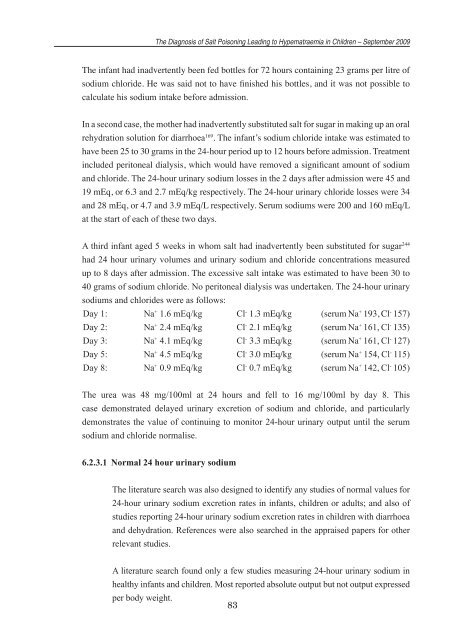The differential diagnosis of hypernatraemia in children, with ...
The differential diagnosis of hypernatraemia in children, with ...
The differential diagnosis of hypernatraemia in children, with ...
You also want an ePaper? Increase the reach of your titles
YUMPU automatically turns print PDFs into web optimized ePapers that Google loves.
<strong>The</strong> Diagnosis <strong>of</strong> Salt Poison<strong>in</strong>g Lead<strong>in</strong>g to Hypematraemia <strong>in</strong> Children – September 2009<br />
<strong>The</strong> <strong>in</strong>fant had <strong>in</strong>advertently been fed bottles for 72 hours conta<strong>in</strong><strong>in</strong>g 23 grams per litre <strong>of</strong><br />
sodium chloride. He was said not to have f<strong>in</strong>ished his bottles, and it was not possible to<br />
calculate his sodium <strong>in</strong>take before admission.<br />
In a second case, the mother had <strong>in</strong>advertently substituted salt for sugar <strong>in</strong> mak<strong>in</strong>g up an oral<br />
rehydration solution for diarrhoea 169 . <strong>The</strong> <strong>in</strong>fant’s sodium chloride <strong>in</strong>take was estimated to<br />
have been 25 to 30 grams <strong>in</strong> the 24-hour period up to 12 hours before admission. Treatment<br />
<strong>in</strong>cluded peritoneal dialysis, which would have removed a significant amount <strong>of</strong> sodium<br />
and chloride. <strong>The</strong> 24-hour ur<strong>in</strong>ary sodium losses <strong>in</strong> the 2 days after admission were 45 and<br />
19 mEq, or 6.3 and 2.7 mEq/kg respectively. <strong>The</strong> 24-hour ur<strong>in</strong>ary chloride losses were 34<br />
and 28 mEq, or 4.7 and 3.9 mEq/L respectively. Serum sodiums were 200 and 160 mEq/L<br />
at the start <strong>of</strong> each <strong>of</strong> these two days.<br />
A third <strong>in</strong>fant aged 5 weeks <strong>in</strong> whom salt had <strong>in</strong>advertently been substituted for sugar 244<br />
had 24 hour ur<strong>in</strong>ary volumes and ur<strong>in</strong>ary sodium and chloride concentrations measured<br />
up to 8 days after admission. <strong>The</strong> excessive salt <strong>in</strong>take was estimated to have been 30 to<br />
40 grams <strong>of</strong> sodium chloride. No peritoneal dialysis was undertaken. <strong>The</strong> 24-hour ur<strong>in</strong>ary<br />
sodiums and chlorides were as follows:<br />
Day 1: Na + 1.6 mEq/kg Cl - 1.3 mEq/kg (serum Na + 193, Cl - 157)<br />
Day 2: Na + 2.4 mEq/kg Cl - 2.1 mEq/kg (serum Na + 161, Cl - 135)<br />
Day 3: Na + 4.1 mEq/kg Cl - 3.3 mEq/kg (serum Na + 161, Cl - 127)<br />
Day 5: Na + 4.5 mEq/kg Cl - 3.0 mEq/kg (serum Na + 154, Cl - 115)<br />
Day 8: Na + 0.9 mEq/kg Cl - 0.7 mEq/kg (serum Na + 142, Cl - 105)<br />
<strong>The</strong> urea was 48 mg/100ml at 24 hours and fell to 16 mg/100ml by day 8. This<br />
case demonstrated delayed ur<strong>in</strong>ary excretion <strong>of</strong> sodium and chloride, and particularly<br />
demonstrates the value <strong>of</strong> cont<strong>in</strong>u<strong>in</strong>g to monitor 24-hour ur<strong>in</strong>ary output until the serum<br />
sodium and chloride normalise.<br />
6.2.3.1 Normal 24 hour ur<strong>in</strong>ary sodium<br />
<strong>The</strong> literature search was also designed to identify any studies <strong>of</strong> normal values for<br />
24-hour ur<strong>in</strong>ary sodium excretion rates <strong>in</strong> <strong>in</strong>fants, <strong>children</strong> or adults; and also <strong>of</strong><br />
studies report<strong>in</strong>g 24-hour ur<strong>in</strong>ary sodium excretion rates <strong>in</strong> <strong>children</strong> <strong>with</strong> diarrhoea<br />
and dehydration. References were also searched <strong>in</strong> the appraised papers for other<br />
relevant studies.<br />
A literature search found only a few studies measur<strong>in</strong>g 24-hour ur<strong>in</strong>ary sodium <strong>in</strong><br />
healthy <strong>in</strong>fants and <strong>children</strong>. Most reported absolute output but not output expressed<br />
per body weight.<br />
83

















